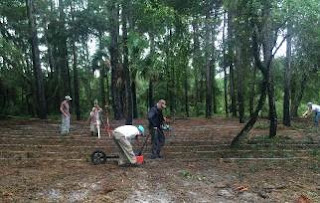Field Notes: Garden Patch Site – Archaeology in a Forest of Thorns (no really, thorns).
Hidden in thorn-laden underbrush and woods, guarded by
mosquitoes and snakes, about 2 miles inland in the Big Bend of Florida, is a
wonderful site called Garden Patch. Two weeks ago, Kevin and I, from East
Central, were lucky enough to go out and assist Neill Wallis and Paulette
McFadden on this site. Dr. Wallis is out of the Florida Museum of Natural
History (FLMNH) and Dr. McFadden is a recent PhD out of the University of
Florida, now a postdoctoral associate at FLMNH. Originally documented by C.B.
Moore over 100 years ago, Dr. Wallis and Dr. McFadden have been working this
site for the past few years and have already completed shovel testing and some excavation
at the site's mounds and village areas (Wallis and McFadden, 2013, 2014; Wallis
et al 2015). They have also investigated nearby island sites to understand the
impact of environmental change, especially sea level rise on prehistoric people in Florida, and how these factors affected decisions of
where to live (McFadden 2014).
To the untrained eye, this site may be just a few mounds, but
it is proving to be pretty important to understanding Florida's Middle Woodland
period (ca. AD100-500) prehistory! Among other things (Wallis and McFadden,
2013, 2014; Wallis et al 2015), archaeology at Garden Patch is demonstrating the
rapid human development of this area, and the process the people who lived
there used to change the landscape. The really cool part is that the pattern
they see at Garden Patch, is the same process as other sites further north,
like the large site of Kolomoki in
southwest Georgia (Wallis et al 2015).
Kevin and I were there to learn more about the site, and to
assist in some remote sensing,
conducted by Dr. Victor Thompson from the University of Georgia. While FPAN is
not geared towards conducting our own research, we are able to assist on
projects!
Now, you archaeology types may already know this, but almost
nothing works out the way you expect when you're doing archaeology. Cars break
down, people get sick, and my goodness does the weather love to change plans.
We had an incredibly successful weekend of GPR, resistivity, and magneticgradiometer survey, with some mapping using a Total Station (stay tuned for a
blog introducing the Total Station and why archaeologists love them so much).
But there were, of course, complications.
Our first day out (FPAN's first day, the rest of the crew
already logged a full day before we arrived) we had a massive rainstorm that
soaked all of us to the bone. There was lightning and thunder, strong gusts of
wind, and it was all we could do to shelter our precious equipment and get it
into the vehicle safely. We made it out, but the rest of our day was spent
indoors, going over the GPR data Dr. Thompson was able to collect before the
rains came.
As determined archaeologists on a schedule, we were up the
next morning and back at it. Dr. Thompson did some magnetic gradiometer survey
while we helped to clear site lines for mapping
(did I mention the thorny vines?).
Dr. Thompson
using the magnetic gradiometer. The signal is disturbed by any metal above the
surface, which means elastic waist shorts and a t-shirt in the mosquito thick
woods. Small sacrifice for such interesting data!
Kevin
setting up the Total Station so we could map a mound.
After a hard day's work of scanning and mapping we headed
out, unfortunately for us, the water on the trail from previous day's rains got
the better of us. Luckily, all of the research was already done!
But we're archaeologists, and this is just part of the story.
We pushed and pulled and dug to try and get the truck unstuck, but to no avail
(always a sad day when digging isn't the answer). Finally, Matt at FWC came to
our rescue, on a Sunday, his day off. Thanks again Matt..
Overall we had an excellent weekend assisting with the
Garden Patch site and we can't wait to read future publications from the work
Dr. Wallis and Dr. McFadden are doing. If we're lucky, we may even get to go
out again and assist them in more fieldwork!
Text and photos: Rachael Kangas, Outreach Assistant, East
Central Region.
References:
-McFadden, P.S., 2014. Archaeological Investigations of
Threatened Stratified Sites in Horseshoe Cove, Northern Gulf Coast, Florida. The Florida Anthropologist
67(4):179-195.
-Wallis, N.J., McFadden, P.S., 2013. Archaeological
Investigations at the Garden Patch site
(8DI4), Dixie County, Florida. Miscellaneous Report No. 63,
Division of Anthropology,
FloridaMuseum of Natural History. University of Florida,
Gainesville.
-Wallis,
N.J.,McFadden, P.S., 2014. Suwannee Valley Archaeological Field School 2013:
The Garden Patch Site (8DI4). Miscellaneous Report No. 64, Division of
Anthropology, Florida Museum of Natural History. University of Florida,
Gainesville.
-Wallis,
N.J., McFadden, P.S., Singleton, H.M., 2015. Radiocarbon
dating the pace of monument construction and village aggregation at Garden Patch: A ceremonial center on the
Florida Gulf Coast. Journal of
Archaeological Science: Reports 2: 507-516.



